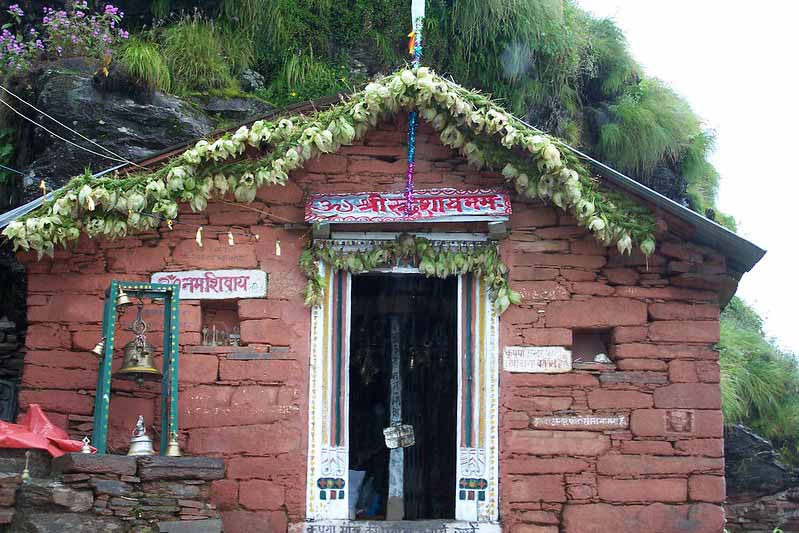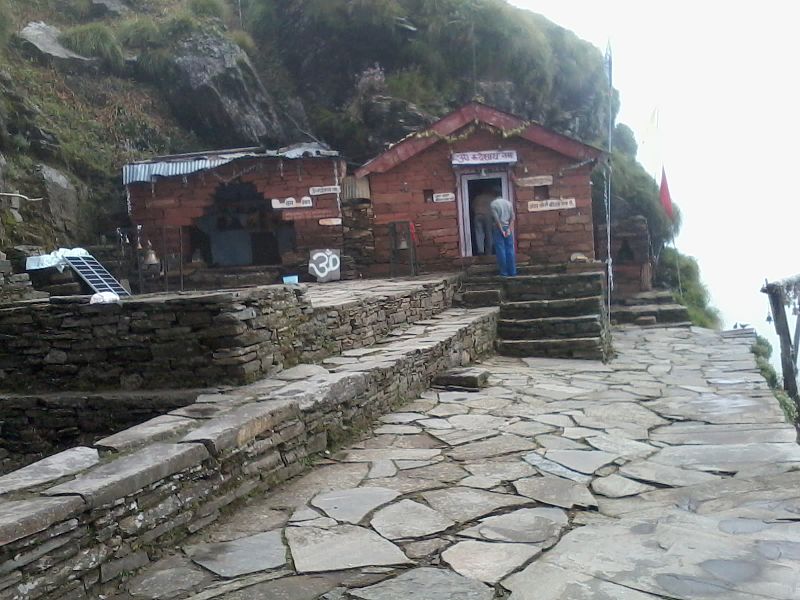Rudranath Temple 2024 | Rudranath Temple History | Rudranath Temple | Rudranath Tourism | Best Time For Rudranath | Rudranath Travel Guide 2024 | History | Timings
Rudranath Temple
Rudranath temple located in the Rudraprayag district of Uttarakhand is revered as the fourth Kedar in the Panch Kedar temples of Lord Shiva. Apart from Rudranath, Panch Kedar temples worship Kedarnath as the first Kedar, Madhyamaheshwar as the second Kedar, Tungnath as the third Kedar and Kalpeshwar as the fifth Kedar.
Rudranath Temple, located at an elevation of 2290 (7513 ft) meters above sea level, is a natural rock temple situated between the rhododendron and alpine meadows. Although the Rudranath temple is much lower than the sea level than other Kedar temples, the journey of Rudranath is the most difficult and the longest among all the Panch Kedar temples.
The walking trek to Rudranath temple is a total of 24 kilometres, which you need at least two days to complete. The mouth of Lord Shiva is worshipped in the Rudranath temple. It is said that Rudranath is the only Shiva temple where Lord Shiva’s mouth is worshipped.
History of Rudranath Temple

It is believed that the Rudranath temple was also built by the Pandavas during the Mahabharata period. According to the legend associated with the construction of the temple, Lord Shiva became very angry with the Pandavas after the war of Mahabharata ended.
Because he had killed his brothers during the war and because of this, the Pandavas became guilty of fratricide. The sage Vyasa, the guru of the Pandavas, suggested him to be free from the sin of fratricide, that if the Pandava somehow appeased Lord Shiva and blessed him then he could be free from the sin of fratricide.
But Lord Shiva was already angry with the Pandavas. Therefore, the Pandavas could not get their blessings, so Lord Shiva went to Kashi. The Pandavas reached Kashi to find Lord Shiva – When Lord Shiva came to know of this, he took the form of an ox and went to Mount Kedar in the Himalayas.
But the Pandavas also reached Kedar mountain in search of Lord Shiva. This time Lord Shiva separated himself into five separate parts to get away from the Pandavas and incarnated in five different places in the Himalayas. Lord Shiva first appeared in Kedarnath and saw his back (hump) here.
After that Lord Shiva’s stomach (navel) incarnated in Madhyamaheshwar. His arms incarnated in Tungnath and his face (face) incarnated in Rudranath. Finally, his hair (hair) appeared in Kalpeshwar.
But the Pandavas also followed Lord Shiva and reached all these five places and worshipped Lord Shiva and established temples in all these places. In the end, Lord Shiva was pleased with the devotion of the Pandavas and blessed all the brothers to be free from the sin of fratricide.
Thus these five temples came to be worshipped as Panch Kedar temples. According to historical evidence, the construction of the Rudranath temple is said to be near the 8th century. In winter, the doors of Rudranath are closed for 06 months. Rudranath’s palanquin is brought to the Gopinath temple in Gopeshwar during the winter season.
Rudranath is worshipped at the Gopinath Temple in Gopeshwar for 06 months.
Rudranath palanquin
Visitation of Rudranath Temple is open for devotees only for 06 months. Visiting Rudranath Temple is closed for devotees from November to May due to excessive snowfall during the winter season. Rudranath’s palanquin is brought to the Gopinath temple in Gopeshwar during the winter season.
When Rudranath’s palanquin is again taken back to the temple during the summer season, Rudra Nath’s Doli reaches Pitrudhar via the route of Luty Bugyal and Panar. After worshipping the ancestors at Pitrudhar, the doli crosses the Dhalbani plain and finally reaches the Rudranath temple.
When the doli reaches Rudranath, Vanadevi is worshipped first in the temple. It is believed that Vandevi protects this temple and the surrounding area. An annual fair is also organized at Rudranath Temple. According to the Hindu calendar, a huge fair is also organized here at the time of Shravan Purnima (July-August).
This annual fair comes at the time of most of the Raksha Bandhan, residents take part in this fair.
Architecture of Rudranath Temple
Rudranath Temple is one of the oldest temples of Lord Shiva situated in the Alpine grasslands of the Himalayas. Regarding the construction of the temple, it is believed that this temple was built by the Pandavas. According to historians, the construction of this temple dates back to around the 8th century.
This temple of Lord Shiva is built in a small natural cave, a small temple has been constructed on the outside of the cave which does not feel much old. Many ancient small temples are also built near the main temple, which can be seen from the ancient history of the Rudranath temple.
Lord Shiva’s face is worshipped in the sanctum sanctorum of the main temple of Rudranath. Rudranath temple is worshipped in the form of Neelkanth form of Lord Shiva, some people also call Rudranath Neelkanth Mahadev.
Geography of Rudranath
The height of the Rudranath temple is 2290 (7513 ft) meters above sea level. A walking tour of the Rudranath Temple situated amidst alpine meadows is considered to be the longest and toughest among the Panch Kedar temples. This ancient temple of Lord Shiva is situated amidst alpine meadows and thick forests of rhododendrons.
A few kilometres from the Rudranath temple, many ancient and sacred water tanks are also built. Chandra Kund, Mana Kund, Surya Kund and Tara Kund are prominent among these water pools. The temple also shows the major mountain ranges of the Himalayas – including Hathi Parvat, Dev Sthan, Nanda Devi, Nanda Ghunti and Trishul. The Vaitarni River flows near the temple.
The river Vaitarni is also called as Baitarani river and Rudraganga. A stone idol of Rudranath has also been installed in the Vaitarni river. Residents also know this river as the “River of Moksha”. There is a belief among the residents that the soul of the dead person reaches another world through this river.
Some other beliefs are also associated with this river, such as if ancestors are offered in this river, then consider that donation as a donation of one crore rupees in the holy city of Gaya. For this reason, many devotees of Lord Rudranath worship their relatives in this river.
Rudranath Temple Timings
Darshan of Rudranath Templisre opens for devotees only during the summer season. Because as the winter gets closer, the cold in Rudranath also becomes very strong. There is also a lot of snowfall in the winter season due to which it is very difficult to reach Rudranath on foot.
Due to this, the doors of Rudranath are closed in the winter season. Rudranath’s palanquin is taken to the Gopinath temple in Gopeshwar during the winter season. Rudranath is worshipped in the Gopinath temple for 06 months during the entire winter season.
Every year, seeing the Panchag, in the auspicious time of Akshaya Tritiya, Rudranath’s palanquin is again taken back to the Rudranath temple. After that, the doors of the Rudranath temple are opened for the devotees to see.
After opening the doors of the Rudranath temple, devotees can visit Rudranath from 06:00 am to 07:00 pm. The chief priests of the Rudranath temple are members of the Bhatt and Tiwari families of Gopeshwar.
Rudranath Temple Opening Date 2022
This year the doors of the Rudranath temple will be opened on 17 May 2021 for the darshan of the devotees.
Rudranath Temple Closing Date 2022
Every year in October and November or after Diwali, the shrines of the Rudranath temple are closed for the devotees to visit. The closing of the doors of the temple is announced every year after Diwali.
Rudranath Temple Aarti Timings
The morning aarti at Rudranath temple takes place at 06:00 in the morning. And the evening aarti takes place at 06:30 in the evening.
Rudranath Trek
The trek to Rudranath temple in Panch Kedar is considered to be the most difficult. To reach Rudranath temple, you have to walk about 24 km. For this reason, walking on the Rudranath temple is considered to be the most difficult. Another reason and you get very few facilities during the entire trek.
Therefore, during the Rudranath trek, you must keep all the things you need with you. Due to the length of the trek, this journey is very tiring, a normal person can complete the Rudranath trek in 02 days. The main trek to Rudranath starts at Sagar village, 5 km away from Gopeshwar, besides two more treks from where Rudranath can be travelled on foot.
One trek then starts from Helang Valley and the other trek starts from Mandal village. But most of the devotees and trekkers prefer to visit Rudranath from the trek starting from Sagar village. Click here for complete information about Rudranath Yatra.
How to reach Rudranath
How to reach Rudranath by Air
Rudranath does not have any type of air service due to it being situated in the middle of the dense mountains of the Himalayas. The nearest airport to Rudranath is the Jolly Grant Airport of Dehradun. Dehradun is very well connected to major airports in the country.
The distance from Dehradun Airport to Rudranath (Gopeshwar) is 258 kilometres. To reach Rudranath, you have to reach Gopeshwar first. The 24-km trek to Rudranath starts from Sagar village, located at a distance of 05 km from Gopeshwar. From Dehradun, you will get a regular bus and taxi service to Gopeshwar.
From Gopeshwar you can start the track of Rudranath by reaching Sagar village.
How to reach Rudranath by Train
By the way, the nearest railway stations of Rudranath are Haridwar, Rishikesh and Dehradun railway stations. But the distance from Rishikesh railway station to Rudranath (Gopeshwar) is only 241 kilometres. From major cities of the country, you will get regular rail service to Rishikesh.
Bus and taxi services are available from Rishikesh to Gopeshwar regularly. From Sagar village, located at a distance of 05 km from Gopeshwar, you can start the track of Rudranath. Rudranath walk is 24 kilometres from Sagar village.
How to reach Rudranath by Road
Gopeshwar is very well connected by road with cities such as Haridwar, Rishikesh and Dehradun. Regular bus and taxi services are available from these three cities to Gopeshwar.
If you are coming to Rudranath by your vehicle, then you can reach Sagar village located at a distance of 05 km from Gopeshwar with the help of your car. Rudranath’s walking tour starts from Sagar village itself.
(If you have reached here in this article, then I have a small request from you to share your suggestions related to this article in the comment box below, and if you see any deficiency or if you find any wrong information, then also definitely Tell me. I keep posting information related to travel on this website, if you like the information given by me, then you must subscribe to my website through my email, thank you)


